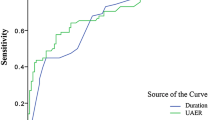Abstract
The aim of the present study was to evaluate the association between diabetic micro-vascular complications with the varied urodynamic manifestations of diabetic cystopathy in both asymptomatic and symptomatic subgroup of patients as shown in previous studies. A total of 63 type 2 diabetic patients are stratified into those with and without voiding dysfunction according to International Prostate Symptom Score (IPSS) score. Urine for albumin/creatinine ratio, direct ophthalmoscopy, and nerve conduction study (NCS) along with multichannel urodynamic study (UDS) were performed to detect diabetic micro-vascular complications. Correlation between urodynamic and micro-vascular complications was evaluated in patients with and without voiding symptoms and compared. Among the 63 patients (34 patients asymptomatic and 29 patients symptomatic), diabetic nephropathy, diabetic retinopathy, motor conduction study (MCS) abnormality, sensory conduction study (SCS) abnormality, and combined NCS abnormality were seen in 74.6, 49.2, 66.7, 65.1, and 65.1 % patients, respectively. On urodynamic study, diabetic cystopathy motor (DCM), diabetic cystopathy sensory (DCS), detrusor overactivity (DO), and bladder outlet obstruction (BOO) were found in 58.7, 54, 34.9, and 36.5 % cases, respectively. Among the micro-vascular complications, sensory nerve conduction studies (SCS), motor nerve conduction studies (MCS), and combined NCS abnormality had significant association with UDS abnormalities in diabetic patients. The association was stronger in symptomatic patients. A large proportion of type 2 diabetic patients have shown clinical and electrophysiologic evidence of neurologic dysfunction which can predict the presence or absence of DCS and DCM even in the asymptomatic stage. The correlation is stronger in the symptomatic group.




Similar content being viewed by others
References
Frimodt-Moller C. Diabetic cystopathy. I. A clinical study of the frequency of bladder dysfunction in diabetics. Dan Med Bull. 1976;23:267–78.
Frimodt-Moller C. Diabetic cystopathy: epidemiology and related disorders. Ann Intern Med. 1980;92:318–21.
Wein AJ. Lower urinary tract dysfunction in neurologic injury and disease. In: Wein AJ, Kavoussi LR, Novick AC, Partin AW, Peters CA, editors. Campbell-Walsh Urology. 9th ed. New York: Saunders; 2007. p. 2011–45.
Harati Y, Bosch EP. Disorders of Peripheral Nerves. In: Bradley WG, Daroff RB, Fenichen GM, Jankovic J, eds. Neurology in Clinical Practice. The Neurological Disorders. 5th ed. Butterworth Heinemann: Elsevier; 2008.pp.2300-6.
Frimodt-Moller C. Diabetic cystopathy: a review of the urodynamic and clinical features of neurogenic bladder dysfunction in diabetes mellitus. Dan Med Bull. 1978;25:49–60.
Mitsui T, Kakizaki H, Kobayashi S, et al. Vesicourethral function in diabetic patients: association of abnormal nerve conduction velocity with vesicourethral dysfunction. Neurourol Urodyn. 1999;18:639–45.
Kaplan S, Te AE, Blaivas J. Urodynamic findings in patients with diabetic cystopathy. J Urol. 1995;153:342–4.
Factors in development of diabetic neuropathy. Baseline analysis of neuropathy in feasibility phase Diabetes Control and Complications Trial (DCCT). The DCCT Research Group. Diabetes. 1988;37:476–81.
Wan EC, Gordon TP, Jackson MW. Autoantibody-mediated bladder dysfunction in type 1 diabetes. Scand J Immunol. 2007;65:70–5.
Bansal R, Agarwal MM, Modi M, et al. Urodynamic profile of diabetic patients with lower urinary tract symptoms: association of diabetic cystopathy with autonomic and peripheral neuropathy. Urology. 2011;77:699–705.
Esteghamati A, Rashidi A, Nikfallah A, et al. The association between urodynamic findings and microvascular complications in patients with long term diabetes but without voiding symptoms. Diabetes Res Clin Pract. 2007;78:42–50.
Chancellor MB, Blaivas JG. Diabetic neurogenic bladder. In: Chancellor MB, Blaivas JG, editors. Practical neurourology. Boston: Butterworth-Heinemann; 1995. p. 149–54.
Ueda Y, Yoshimura N, Yoshida O. Diabetic cystopathy: relationship to autonomic neuropathy detected by sympathetic skin response. J Urol. 1997;157:580.
Kitami K. Vesicourethral dysfunction of diabetic patients. Nippon Hinyokika Gakkai Zasshi. 1991;82:1074–83.
Daneshgari F, Huang X, Liu G, et al. Temporal differences in bladder dysfunction caused by diabetes, diuresis, and treated diabetes in mice. Am J Physiol Regul Integr Comp Physiol. 2006;290:R1728–35.
Clark Jr CM, Lee DA. Prevention and treatment of the complications of diabetes mellitus. N Eng J Med. 1995;332:1210–7.
Cheng JT, Yu BC, Tong YC. Changes of M3-muscarinic receptor protein and mRNA expressions in the bladder urothelium and muscle layer of streptozotocin-induced diabetic rats. Neurosci Lett. 2007;423:1–5.
Rizk DE, Padmanabhan RK, Tariq S, et al. Ultra-structural morphological abnormalities of the urinary bladder in streptozotocin-induced diabetic female rats. Int Urogynecol J Pelvic Floor Dysfunct. 2006;17:143–54.
Mumtaz FH, Khan MA, Thompson CS, et al. Nitric oxide in the lower urinary tract: physiological and pathological implications. BJU Int. 2000;85:567–78.
Su X, Changolkar A, Chacko S, et al. Diabetes decreases rabbit bladder smooth muscle contraction while increasing levels of myosin light chain phosphorylation. Am J Physiol Renal Physiol. 2004;287:F690–9.
Acknowledgments
We thank Dr. Ramesh Bhattacharya, Department of Neuromedicine, Calcutta National Medical College, for allowing us to do nerve conduction studies and help to interpret the same.
Ethical standards
This study was approved by the Institutional Ethics Committee of Calcutta National Medical College, Kolkata, India [Dated 3rd December, 2012].
Funding
This study was not funded.
Conflict of interest
Partha Pal, Sayantan Ray, Nabankur Ghosh, Sujoy Ghosh, Kaushik Biswas, Krishnendu Roy, Debabrata Mukherjee, and Dilip Karmakar declare that they have no conflict of interest.
Ethical approval
All procedures performed in studies involving human participants were in accordance with the ethical standards of the institutional and/or national research committee and with the 1964 Helsinki Declaration and its later amendments or comparable ethical standards.
Informed consent
Informed consent was obtained from all individual participants included in the study.
Author information
Authors and Affiliations
Corresponding author
Rights and permissions
About this article
Cite this article
Pal, P., Ray, S., Ghosh, N. et al. The association between urodynamic findings and micro-vascular complications in type 2 diabetic patients with or without voiding symptoms. Int J Diabetes Dev Ctries 36, 103–112 (2016). https://doi.org/10.1007/s13410-015-0446-5
Received:
Accepted:
Published:
Issue Date:
DOI: https://doi.org/10.1007/s13410-015-0446-5




